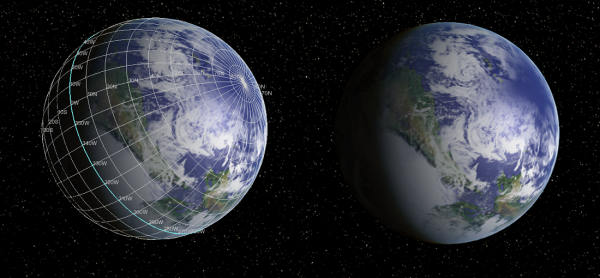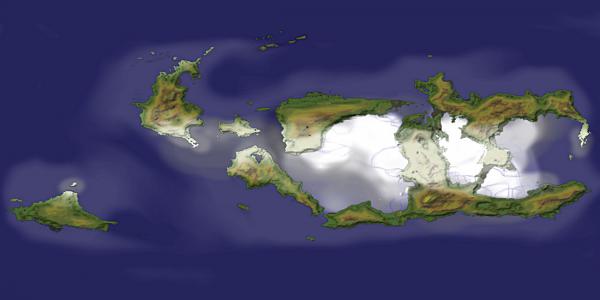BY LETTER
Whirlygig
Galactography > Regions of Space > Inner Sphere
Galactography > Systems and Worlds > Systems & Worlds W - X
Galactography > Sephirotic Empires > Terragen Federation
Galactography > Systems and Worlds > Systems & Worlds W - X
Galactography > Sephirotic Empires > Terragen Federation
Terrestrial planet with high obliquity | |
 Image from Steve Bowers | |
| The coolest part of the planet Whirlygig is the equator, where permanent ice floes form in enclosed seas | |
Whirlygig — data panel | |
| Star | Freckles, 94.4 LY from Earth, HD 35956 |
|---|---|
| Class | G0V: 5765K, 1.08 Solar masses, 1.1 Solar radii, luminosity 1.4 x Sol |
| Planets | Aphrodite XI Cytherian, 0.75AU, 0.9 terrestrial masses Whirlygig Skolian Gaian, 1.2AU, 1.1 terrestrial masses, 1.3 standard year orbit Crumbles Asteroid Belt, 2.5AU to 4.2AU Blatt EuJovian, 7.6AU, 2.1 jovian masses Zodiac Asteroid Belt, 11AU to 30AU Gemini LithicGelidian, 35AU, 0.69 terrestrial masses |
| AI Ethos | Independent experimentalist, The Blatt ISO |
| Local Government | AI direct rule under Terragen Federation suzerainty |
| Colonized | 3315AT |
| Population | Whirlygig 50,000,000 nebs; Blatt 1,000,000 nebs; small numbers of visiting sus and transapients |
| Travel | One 'hot' Beamrider link to New Duibbiyat |
| Hazard Rating | 1 |
SYSTEM OVERVIEW
Freckles is a star system in the Terragen Federation some 94 light-years from Earth. Its skolian planet in the habitable zone, Whirlygig, was terraformed by real estate speculators during the 4th Millennium but the first and only customer is the Blatt ISO. The then-S2 entity acquired the system at its pre-auction quick sale price and has apparently settled in to treat the system as an art project. Blatt has ascended to an S3 state and occupies an M-brain ISO circling the eponymous gas giant Blatt; the high transapient prefers to be addressed as 'The Blatt ISO' to avoid confusion with the planet. The star is so-named because of numerous starspots.The Blatt ISO appears to be using the system to experiment with different ecologies, both terrestrial and exotic, making Whirlygig and Aphrodite XI both "potted planets." Eir activities on Whirlygig seems to be modifying Earth-derived plants and animals to help them thrive in the unusual environment and, on a larger scale, producing biomes that apparently exhibit some beauty to transapients in the plants' and animals' distribution patterns, activities, and modification of environments. Modosophonts agree the various biomes of Whirlygig are scenic, but they are not as outright attractive (to lesser minds) as the Tar Vara habitats. E is also creating an entirely artificial, non-biont ecology (a botworld of crystalline and ceramic bots) on Aphrodite XI. Eir interactions with Aphrodite XI's bots and mechology are much more direct and frequent than the small genetic adjustments that typify The Blatt ISO's interactions with Whirlygig's species.
Modosophont residents are accepted and a small population has grown from tourist industry workers, or modosophonts seeking "the simple life" as prims or lo teks on Whirlygig. Residents are from many different clades across the Terragen Federation. The Blatt ISO imposes strict technology limits on Whirlygig with the stated goal of minimizing large-scale impact on eir ecological projects. These restrictions are primarily with respect to manufacturing and construction technologies. Long-term residents of Whirlygig may have high and ultratech possessions, Known Net access, and anachrotech implementations of prim tools, but must live in prim dwellings and import their advanced belongings. This is not much of a hardship because Whirlygig's large, close moon Gizmo is dotted with small ultratech communities that are under no such restrictions and, in fact, have antimatter and comm gauge wormhole facilities that could endanger the planet in the minute chance that something went wrong.
With The Blatt ISO moderating the activities of most inhabitants, Freckles has an unexciting history. It has been inhabited by a small population of peaceful, angelnetted prim and lo tek farmers who spend their days farming, herding, and producing low tech crafts, and their evenings interacting with each other or exploring the Known Net. It is the planet, not the people, that attracts a trickle of tourists.
Freckles' system is a bit sparse. A few planets shepherd large, stable asteroid belts. Large Blatt has predictably swept a significant gap in the two belts and hosts an enormous, spectacular ring system much more visible from Whirlygig than the diffuse belts. Over a million modosophonts permanently live among the rings on small moons, on Dyson Trees, in bubblehabs, and in other habitats that afford them a good view of the rings. The Blatt ISO has converted a major moon into an M-brain. Aphrodite XI is a dry Cytherean "hell world" that earned its name because it is reportedly the eleventh Cytherean planet to be named Aphrodite.
Whirlygig — physical features | |
 Image from Steve Bowers | |
| The ice floes in certain closed seas around the equator are permanent, but do shrink somewhat at equinox. | |
WHIRLYGIG
Whirlygig is a classic Skolian gaian world. It has an axial tilt of 71 degrees, which appears to be a product of the impact that produced its moon, Gizmo. Gizmo, which has a low inclination to Whirlygig's equator, has helped stabilize the planet's tilt against external influences like Freckles and Blatt. Whirlygig is an ocean world (85% salt water coverage), with continents mostly clustered along its equator.The high tilt produces some unusual seasonal effects and temperature distributions across the planet. For a quarter of the year (about 115 days per season), each pole is mostly aimed at Freckles and experiences a summer under near-continuous illumination. The interiors of the larger arctic and Antarctic islands may see temperatures exceed 80° C, while sea surface temperatures regularly exceed 40° C at the peak of summer. The opposite pole, of course, experiences a winter of near-continuous darkness. The shortage of land prevents permanent polar ice caps from forming, though, keeping albedo low by the time spring arrives. Spring and autumn more evenly divide Whirlygig's 19-hour days for the poles, but they are warmed by Freckles during these seasons. This contrasts with the equatorial region, which is highly oblique to the star during half the year (the polar winter and summers) and only spend half their days illuminated during spring and autumn. The result is that the poles receive more energy than the equator through the year and gives the world a permanent equatorial ice belt interrupted at only the largest channels between continents. Seasonally, sea ice may shroud the polar regions but the onset of ice coverage is delayed until later in winter by the huge thermal masses of the polar oceans. Polar springs are likewise cool as it takes some time for the ice packs to fade.
Residents prefer to make their homes on islands in middle-lower latitudes where temperatures are moderate and they can bunker down against the severe summer storms that brew on the hot polar oceans. Favored island clusters are in the path of warm currents crossing the equator, which buffer the islands against winter temperatures. The highly tilted planet and its two large oceans is prone to disrupting a hemisphere's summer and winter Hadley cell circulation, and thus large-scale weather patterns are turbulent and vary rapidly over short periods. Similarly, polar regions are lashed in winter by the high winds that can build up over the vast, flat stretches of sea ice. Tourists and adventurers, on the other hand, enjoying trekking the winter sea ice, which may be sculpted by the winds into exotic sastrugi. During the summer, the well-mixed polar seas are rich in life that draw fishers into the stormy waters.
The planets' ecosystem is modified terrestrial. The Blatt ISO has not been particularly innovative with survival-related genes, instead preferring to purchase or duplicate genes proven on other worlds with extreme gaian environments. Instead, eir innovation is creating emergent behaviors and interactions between species and the land that e considers attractive.
Animals and plants have been engineered to tolerate the long, dark months of winter via hibernation, migration, and food storage. For example, smaller animals such as rabbits, parrots, and raccoons exhibit new habits of collecting, storing, and protecting food in their dens and nests. When possible (either due to suitable locomotion or contiguous land), animals tend to migrate between summer and winter grounds even if their terrestrial ancestors exhibited no such behavior. Many animals now are able to build up layers of blubber during spring, summer, and autumn, and efficiently metabolize it during winter. In addition to putting on weight during the warmer seasons, most larger mammals have autumn mating seasons to gestate during hibernation. To battle summer heat, sweat glands have been added to animals that previously only panted, and many animals favor nocturnal activities if their latitude has night during the summer. Burrowing into cooler soil is another widespread new habit, and heavy winter coats are shed rapidly during spring in favor of lighter coats that work synergistically with sweat glands.
Terrestrial plants have been grafted with genes appropriate to their environment, gaining cold- and hot-weather adaptations. Like the animals, most plants gain the ability to store a significant amount of energy, typically in the form of starches and sugars, and sometimes water (in the manner of baobab trees or cacti). On polar lands that see the highest summer temperatures, plants will usually survive the summer as deeply-buried roots in cooler soil, regrowing their above-ground leaves and trunks in cooler seasons. Some actively thermoregulate, either using transpiration to cool or metabolizing starch to warm.
The Blatt ISO's genetic experiments do not directly extend to sophonts, apparently because this would cause too much legal bother in the Terragen Federation, but it is thought eir technology restrictions on Whirlygig are meant to produce a specific environmental impact. A number of residents have adopted extreme-environment modifications to better tolerate Whirlygig's polar summers and winters, drawing on existing tweak high and/or low temperature genemods. Facultative hibernation is also a popular option for residents who worry about finding themselves in food-deprived situations. These "Whirlytweaks" are a small part of the planet's population, distinct enough to be considered a subclade, but their gene tweaks have not been universally adopted. This is because the inhabited islands of the middle latitudes rarely experience temperature extremes made possible by the skolian environment as the ocean buffers the islands' temperatures. Further, the seasons are only slightly longer than Earth's and thus it is not a great challenge to stockpile sufficient food and supplies to last through the winter. Finally, and perhaps most significantly, a distressed resident is almost always able to receive prompt help (in less than two hours) from the planet's angelnet, whether that's a cache of food, medical aid, or an emergency shelter. A resident must be unusually stubborn to depend on physiological mods rather than calling for help.
Related Articles
Appears in Topics
Development Notes
Text by Mike Miller
Initially published on 07 July 2015.
Initially published on 07 July 2015.






